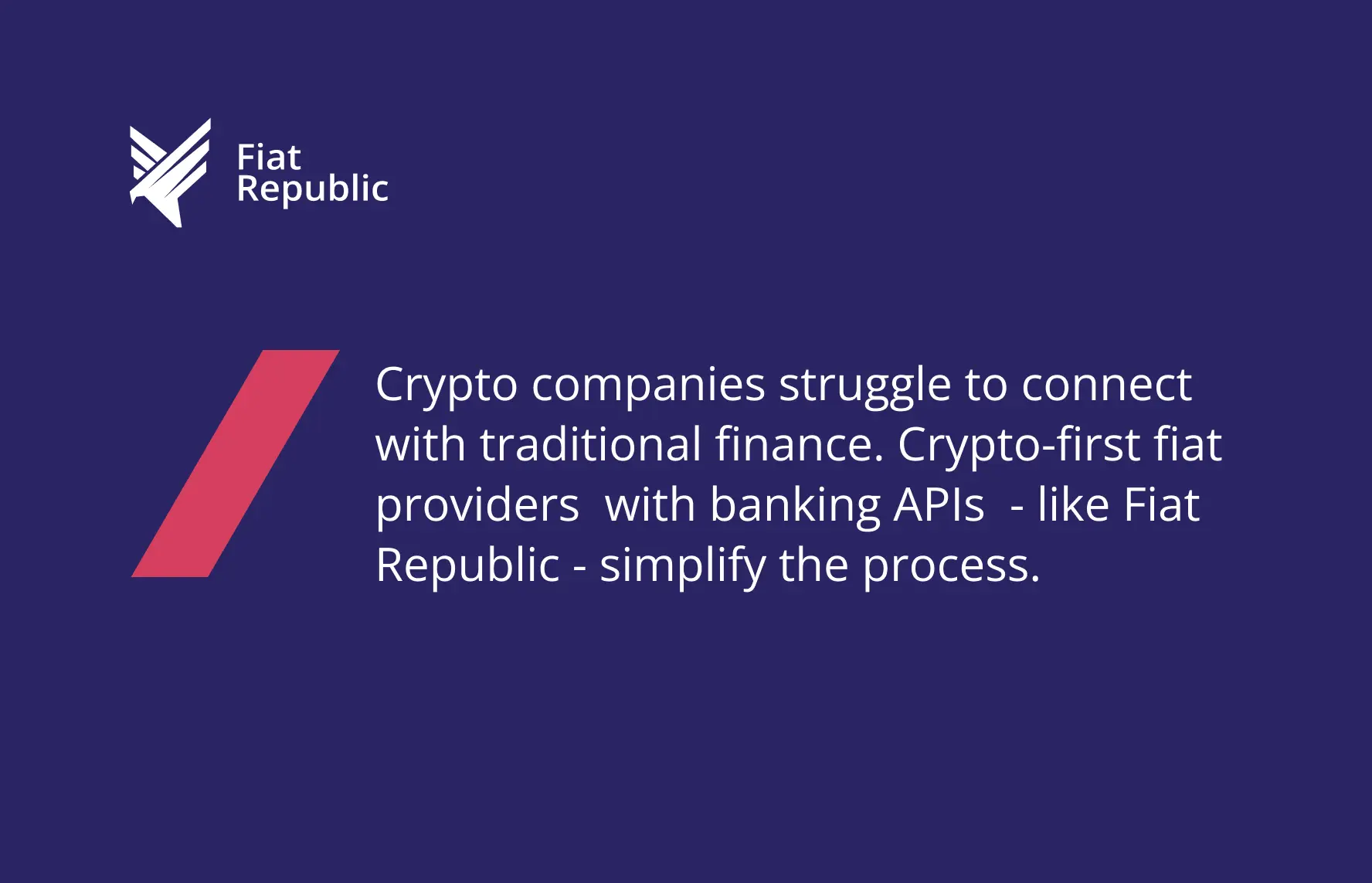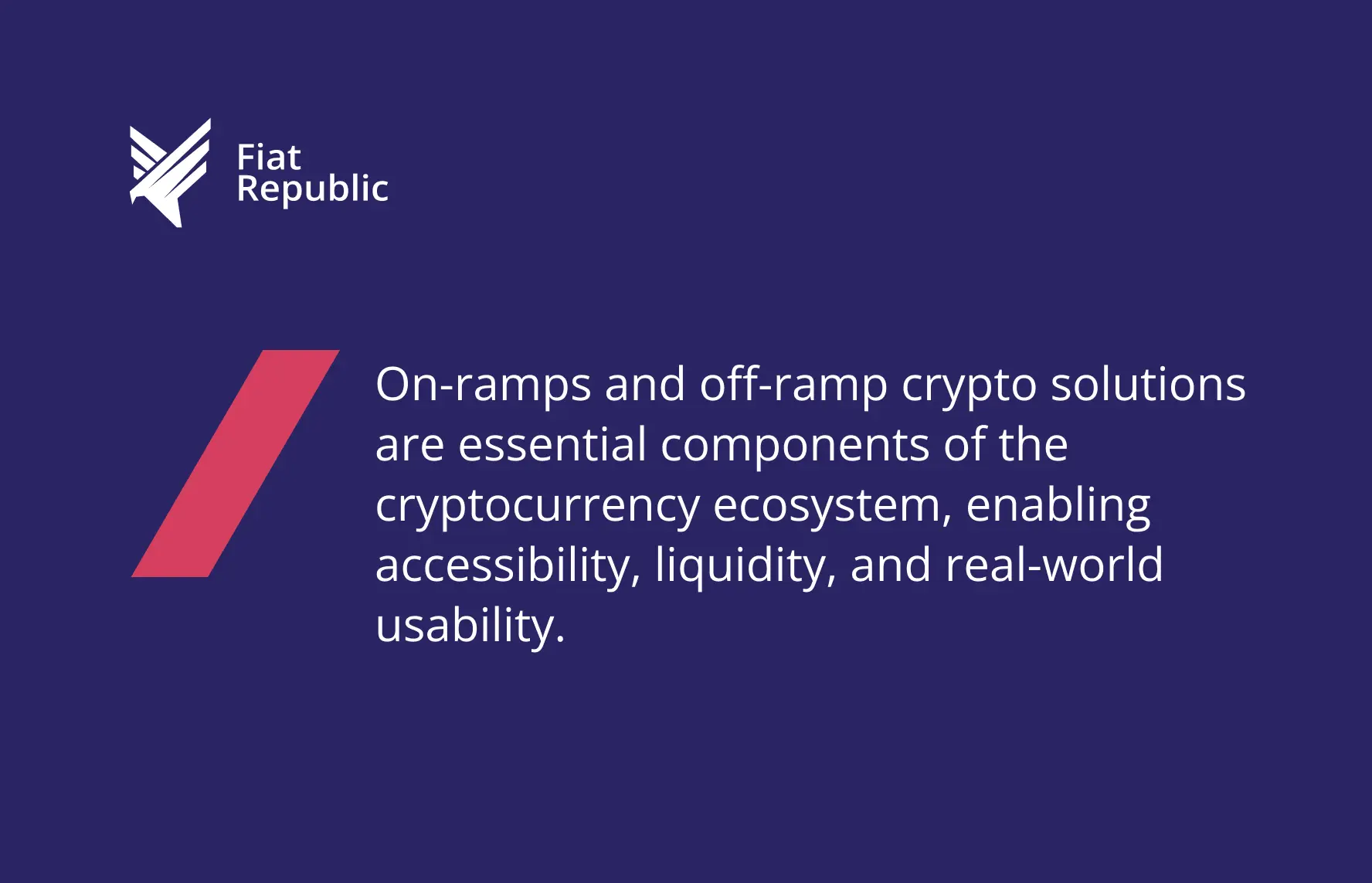Understanding on-ramp vs off-ramp: the key to cryptocurrency accessibility

Introduction to cryptocurrency on-ramps and off-ramps
In cryptocurrency, on-ramps and off-ramps are crucial in facilitating accessibility and adoption. These entry and exit points allow users to convert between fiat currencies and cryptocurrencies, enabling liquidity and real-world use cases.
Understanding the various on-ramp and off-ramp options is essential for users and businesses as the crypto industry evolves.
What do on-ramp and off-ramp mean?

An on-ramp allows users to convert their fiat currency into cryptocurrency. These on-ramps can take various forms, such as centralized exchanges, decentralized platforms, or physical locations like crypto ATMs. On the other hand, off-ramps are the exit points that allow users to convert their cryptocurrencies back into fiat currency. Stablecoins, which are pegged to the value of fiat currencies, often serve as a bridge between the two, providing stability during the transition.
On-ramps and off-ramps are vital for the growth and mainstream adoption of cryptocurrencies. They provide the necessary infrastructure for users to quickly enter and exit the crypto market, enabling them to participate in the ecosystem. Moreover, these ramps facilitate liquidity, allowing users to convert their crypto holdings into fiat for real-world purchases or investments. By creating a “Web 2.5” network of trust, on-ramps and off-ramps bridge the gap between traditional finance and the crypto world.
Related posts
- Why banks don’t trust the current bridge to crypto and how Web 2.5 can fix it
- Why without Web 2.5, there’ll be no Web 3.0
Exploring the crypto on-ramp
There are several ways for users to acquire crypto assets, each with advantages and considerations.
Centralized vs. decentralized exchanges
Centralized exchanges, such as Coinbase and Binance, offer user-friendly interfaces and are subject to regulatory oversight. These platforms often require users to complete KYC and AML procedures, which can provide a sense of security but may compromise privacy. On the other hand, decentralized exchanges (DEXs) operate on blockchain networks, allowing for peer-to-peer trading without intermediaries. DEXs offer users more control and anonymity but may have limited fiat on-ramp options.
Peer-to-peer platforms
Peer-to-peer (P2P) platforms facilitate direct transactions between users, often with the help of escrow services to ensure secure trading. These platforms, such as LocalBitcoins and Paxful, allow users to buy and sell cryptocurrencies using various payment methods, including bank transfers, cash deposits, or even gift cards. P2P platforms provide flexibility and privacy but may involve higher risks and require due diligence when dealing with counterparties.
Crypto ATMs and direct purchases
Crypto ATMs are physical machines that allow users to buy cryptocurrencies using cash. These ATMs are increasingly common in major cities worldwide, providing a convenient way for individuals to acquire crypto. Some cryptocurrency providers offer direct purchase options, allowing users to buy crypto using credit cards or bank transfers, simplifying the on-ramp process.
Understanding crypto off-ramps
Using an off-ramp for cryptocurrencies involves converting digital assets into fiat currency, which can be done through various methods.
Converting crypto to fiat
One standard off-ramp method is withdrawing funds from crypto exchanges to bank accounts. Users can sell their cryptocurrencies on exchanges and then initiate a withdrawal request to receive the fiat currency in their linked bank account. This process is subject to the exchange’s withdrawal limits and may require additional verification steps.
Crypto debit cards and payment services
Crypto debit cards, such as those offered by companies like Coinbase and Binance, allow users to spend their cryptocurrencies directly for goods and services. These cards instantly convert the crypto to fiat at the point of sale, providing a seamless way to use digital assets in everyday transactions. Similarly, BitPay enables businesses to accept crypto payments while receiving the equivalent fiat currency in their bank accounts.
Regulatory aspects of off-ramps
Using an off-ramp for cryptocurrencies often involves compliance with local laws and regulations. Users may need to report their crypto transactions for tax purposes and adhere to specific reporting requirements. It is essential to stay informed about the regulatory landscape in your jurisdiction to ensure compliance when off-ramping crypto.
Ramp challenges that crypto businesses face
The intersection of fiat and crypto can be a weak point in business operations, presenting various challenges for crypto companies.
Poor user experience due to cautionary measures
Banks may sometimes block off-ramp transactions due to their AML policies and lack of trust in the crypto industry. This can result in false positives and a poor user experience. To mitigate these consequences, crypto exchanges can grant virtual IBANs to users, providing a more reliable off-ramp solution.
The risk of getting debanked

Traditional banks often view crypto as a high-risk industry, and their risk appetite may change at any point. Crypto companies risk getting debanked, leaving them unable to facilitate ramping. To address this issue, crypto businesses can opt for fiat solutions that aggregate banking connections, reducing their reliance on a single banking infrastructure.
Establishing banking connections is time and resource-consuming

Crypto companies often face numerous requirements and hurdles when establishing connections with traditional financial institutions. Meeting these technological, structural, and regulatory requirements can be time-consuming and resource-intensive, and success is not guaranteed. Partnering with crypto-first fiat providers (like Fiat Republic) that offer easy API integration with existing banking partners can streamline this process.
Related post:
The role of regulation in crypto transitions
Regulatory compliance is a critical aspect of the entire user journey in the crypto industry.
KYC and AML compliance
Crypto platforms must implement robust KYC and AML procedures to verify user identities and prevent illicit activities. This includes collecting and verifying user information during onboarding and continuously monitoring transactions for suspicious patterns.
Impact on user anonymity
Regulatory compliance often requires a balance between user privacy and adherence to legal requirements. Different platforms may offer varying levels of anonymity, depending on their jurisdiction and the extent of their compliance measures. Crypto platforms must learn how to communicate effectively with banks and regulators to ensure a smooth user experience while maintaining compliance.
Selecting the best ramps
When choosing ramps, users should consider several key factors to ensure a secure and efficient experience.
Security and user experience
The security of user funds and personal information should be a top priority. Look for platforms with robust security measures, such as two-factor authentication and cold storage for digital assets. Additionally, consider the user experience, including the ease of navigation, customer support, and available trading features.
Fees and accessibility
Compare the fees charged by different platforms for ramp services. Some exchanges may offer lower costs but have higher minimum transaction amounts or limited payment options. Consider your specific needs and budget when evaluating the cost-effectiveness of each platform. Also, consider the geographic availability and supported payment methods to ensure accessibility in your region.
Supported cryptocurrencies and fiat currencies
Different platforms support varying ranges of cryptocurrencies and fiat currencies. The most common traditional fiat currencies are USD, GBP, and EUR. The most common cryptocurrencies for ramping are Bitcoin and Ethereum, as well as the USDT and USDC stablecoins. Consider the digital assets you wish to buy or sell and ensure the chosen platform supports them. Similarly, check the compatibility with your local fiat currency for seamless ramping transactions.
Conclusion

On-ramps and off-ramp crypto solutions are essential components of the cryptocurrency ecosystem, enabling accessibility, liquidity, and real-world usability. As the industry matures, it is crucial to develop secure, accessible, and compliant solutions that cater to the needs of both users and businesses. By understanding the various ramp options, their associated challenges, and the role of regulation, crypto platforms can navigate the complex landscape and contribute to the growth and mainstream adoption of digital assets.
Related posts
Why winning platforms are choosing fiat as a service
Fintech Founders: How to bridge Web3 and Banking?



